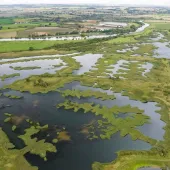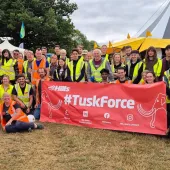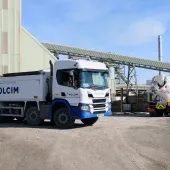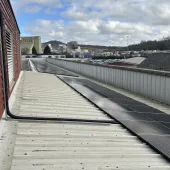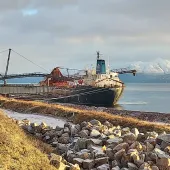Archaeology: A Threat Or An Opportunity?

John Penny, area estates manager for Aggregate Industries, looks into the debate and draws on his own experiences in the past few years
There has long been a relationship between quarries and archaeology. Records show that in the first half of the 19th century, deep sequences from quarries were used to help identify and establish the geological time sequence of the planet. More recently, during the latter part of the 1800s, soil stripping within quarries provided the first opportunities for the excavation of later prehistoric and Roman settlements in Britain, something that may not have occurred had it not been for the process of quarrying.
It would be fair to say, therefore, that quarries could be, and in some cases have become, laboratories of time. But is this relationship a threat or an opportunity for quarrying companies?
Sand and gravel quarries are being increasingly highlighted as an important source of information for geologists, palaeontologists and archaeologists, both through the planning system and on a voluntary basis, with organizations and individuals negotiating with mineral operators to gain access to quarry sites.
Excavations for quarrying have brought to light geological sequences, the fossil remains of plants and animals, and the stone tools of some of our earliest ancestors. Modern planning practices help ensure that many of these finds are collected and recorded without them being lost, as has happened in the past.
The challenge, not only for companies such as Aggregate Industries, but for the archaeology industry is to continue closely monitoring quarries for significant finds, something that can only be achieved through partnership between geologists, palaeontologists and archaeologists, between professionals and amateurs, but most of all with the aggregates industry.
But while quarrying is a way to uncover the past, the discovery of an archaeological find at a site usually causes mixed feelings – excitement that it might be something of significant historical value, and nervousness as operations may need to be modified to cater for the presence of archaeological remains. Archaeological excavations can often involve substantial and unexpected costs to the quarrying company.
Many sites contain artefacts of interest, but it is sand and gravel sites that tend to contain more significant finds from across the ages. One such site is Aggregate Industries’ Pode Hole Quarry, near Peterborough, which has recently been the site of two major discoveries on an extension area permitted in 2005.
The potential for archaeological interest was originally highlighted following both desk-based and field assessments (trial trenching and geophysics) undertaken as part of the planning application process for the quarry extension.
The company’s eight-year relationship with Phoenix Consulting Archaeology Ltd has resulted in a number of excavations taking place around the quarry with items such as Bronze Age axes, palstaves, spear heads and an anvil all being found.
In July 2007, the well-preserved remains of a man, thought to have lived more than 3,500 years ago, were unearthed. The Middle Bronze Age skeleton, which was uncovered by Phoenix, was found as part of routine archaeological work during soil-stripping operations under the terms of an approved archaeological scheme.
Less than three months later a child’s skeleton which is believed to have come from same farming community was found at the site. The barrow that housed the child’s remains measured over 25m across and has so far revealed the child burial with associated grave goods in the form of a complete pottery vessel and perforated sea shell. The remains were also found placed in a grave lined with what appears to be birch bark.
Once the investigations on site were completed, the skeletons and artefacts were sent for testing to gain a better understanding of past communities, and to determine age, sex, diet, disease and dental information, providing a unique insight into our Bronze Age ancestors.
As a large area of the quarry was the subject of an archaeological watching brief on soil stripping, specific areas could be cleared quickly for mineral extraction so that the intensive excavations of the barrow did not impact on day-to-day quarrying operations.
The Pode Hole Quarry excavations are successfully piecing together the jigsaw of the past. Eight years of investigations have identified an extensive agricultural landscape, allowing for an increased understanding of the economic aspects of the Bronze Age. The latest excavations of the round barrow cemetery will allow the archaeologists to better understand the social aspects of these past communities.
While many questions have been raised about whether archaeology and archaeological work should be considered a threat or an opportunity to the quarrying industry, Aggregate Industries remain fully committed to supporting archaeological investigations. The author has seen first hand the amazing evidence a dig can produce, providing a valuable source of information to historians and the local community and providing a way to uncover the past. And with careful planning the impact on day-to-day quarrying operations can be mitigated.
A mix of positive planning and management can help to bring about sensible solutions to the treatment of sites with archaeological remains and to reduce the areas of potential conflict between development and preservation.
But what is key in order for the archaeological and the quarrying industries to work well together is acting within the framework set by central government. This can be in their various capacities as planning, education and recreational authorities, as well as with the owners of sites themselves. Appropriate planning policies in development plans and their implementation through development control is especially important to provide clear and reasonable guidelines for the industry to work to.
It remains both our and the quarrying industry’s duty, as a supplier of essential raw materials, to balance the needs of the construction industry and the understanding of our past, a duty which should be placed high on the agenda.


